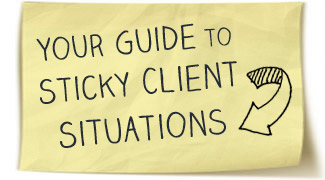
At the end of the year, most of us are in one of three states:
- swamped trying to finish projects before the holidays
- already checked out for the holidays
- scrambling to line up business for after the holidays
No matter which phase you’re in, dropping everything to perform a proper review of your previous year’s work, goals, and finances doesn’t seem like a high priority.
But there’s no way to improve consistently and keep your business moving in the direction you want without checking in, so I’ve assembled and put together the quick and dirty (but effective) version.
It’s a simple set of questions to work through that you can do all in one go or in 5- or 15-minute spurts here and there. When you’re done, you’ll not only have a complete picture of what happened with your business the previous year and where you want to see it go in the next, but also a personal plan to move in the right direction.
Profits, Losses, and Spreadsheets: The Numbers You Really Need
For any business manager, a profit and loss statement is a key part of evaluating how business is going. But self-employed women and freelancers use a variety of accounting methods, from a simple spreadsheet to a CPA on retainer, these don’t apply to everyone.
Thankfully, there are only a FEW numbers you really need to look at during your annual review:
Business Expenses
- Were these way out of line with your income?
- If so, is that okay? (i.e. you’re investing for a future growth plan)
- Did your major expenses pan out into business gains in the way you were expecting?
- If not, what can you do differently next year?
Business Income
- How much did you make overall?
- What was your average hourly rate?
- Which client payed you the most?
- The least?
Business Development
- How many clients did you work with?
- How many were new this year?
- How many prospects did you discuss new work with?
- What percentage panned out?
- Where did most of the leads that worked out come from?
- What times of year saw the most new clients?
What Have You Gotten Done in the Last Year?
Think of this like a great big “I’m awesome” list (because you are).
Go through your time tracker, invoices, and spreadsheets—-wherever you need to look—-and make a tally of everything that you’ve done this year.
Make sure to include things you’ve billed for as well other important things you’ve done for your business, such as:
- attending industry conferences
- personal marketing, from new business cards to a new website
- outsourcing to free more time for your core tasks
Now look at that list and distill it down into some hard numbers that you can use in your marketing and to remind yourself that this was a good year in many ways no matter what else happened.
- if you’re a coach, how many hours of coaching did you do?
- if you’re a writer, approximately how many words or articles did you write?
- if you’re a social media consultant, how many tweets did you write?
What Worked, What Didn’t, and Why
Now that you’ve taken a little time to remind yourself what you did the past year, let’s look at your five best moves and your five worst moves for the year.
Don’t worry if you don’t capture the best of the best and the worst of the worst. The point of this exercise is not reward or blame, just learning:
- How did those best moments come about, and how can you create a climate for more moments like those?
- What were the factors that led to your worse moves, and what can you put in place to prevent yourself from ever having the same type of failure.
Where Did You Think You Would Be Right Now?
Whether or not you made specific goals for the year last year, let’s travel back in time to this point last year. Try to remember what you felt the year ahead would bring:
- What issues did you know that you would face this year?
- Did they come up?
- How did you handle them?
- What opportunities came up this year that changed you plans?
- Are you working with the same clients or new ones? How do you feel about that?
What Happened to Your Goals for 2014?
Now, let’s look specifically at your goals. Depending on how your year has been, this will feel very easy or very difficult.
If you met all your goals, congratulations! Do you know what that means?
You need to set bigger, scarier goals for the year ahead to capitalize on your momentum.
If you didn’t meet your goals, take a look at why:
- Did your goal cease to be important or relevant for some reason?
- What can you replace it with now?
- If your goal is still important to your business, what can you do today to start on the path to achieving it?
In the next part of our year-end business recap, we’ll walk through exactly how you can set up goals that will motivate you, even when you feel like you’ve gotten off track.





